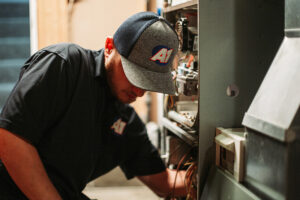In the winter, those of us who live in cold climates have a lot to deal with. It’s not just the temperature. The snow and ice close schools and cause unsafe driving conditions. Even the low humidity has impacts that make winter challenging. We can’t control the weather, but we can help with that dry air! Here are some important things to know about using a humidifier in the winter. A member of our team of air quality experts would love to talk with you if you have questions about whole house humidifiers or the ideal humidifier setting for winter in Okemos, MI.
Impacts of Dry Air
Moist air is better at holding heat and making people feel warmer. That’s why extreme humidity in the summer can make you feel hotter than being at the same temperature with lower humidity. So when your indoor air is dry, you’re much more likely to feel chilled, and you’ll be likely to set your thermostat higher, use your heat more, and have higher heating bills.
Dry air has other impacts, too. Your nails, hair, and skin can easily get uncomfortably dry, leading to cracking and itching. And this affects your health as well. One of the reasons that cold and flu germs have an easier time making people sick in the winter is that the dry air damages the mucous membranes of the sinus passages. When it’s dry and cracking in there, it’s easier for germs to get in.
Whole House Is the Way to Go
Small, portable humidifiers exist, but they only have a minor effect on humidity. They can be great in very small areas, like a dorm room. But to have any meaningful impact on your entire home, you need a whole house humidifier. These are installed by an HVAC professional to connect with your ductwork and humidify all the air that passes through it.
Get Familiar with Your Humidistat
A hygrometer is a device that measures humidity, the way a thermometer measures temperature. But a humidistat is like a thermostat. It not only takes the measurement, it uses that information to control an appliance. The humidistat can be set to various percentages, and you might find you need to adjust and fine-tune it depending on the weather outside.
Outdoor Temp and Indoor Humidity
It’s usually recommended that indoor humidity be kept between 30 and 50%. And that’s perfect during swampy summer weather when you’re trying to keep the humidity low enough. But when you’re trying to get the humidity higher in winter, what percentage you need will depend on exactly how cold it is outside.
If it’s around 30 degrees outside, a humidity of 40% is great. But as it gets colder, too high an indoor humidity can lead to condensation developing indoors on walls and windows. You don’t want to end up with water damage or mold growth, so as it gets colder, you should set your humidistat lower. At 10 degrees, 30% is better, and if it’s well below zero, you’ll want to drop the humidity to 20%.
Contact A-1 Mechanical Heating & Cooling for humidifier services in Lansing, MI. Comfort and Character You Can Depend On.

